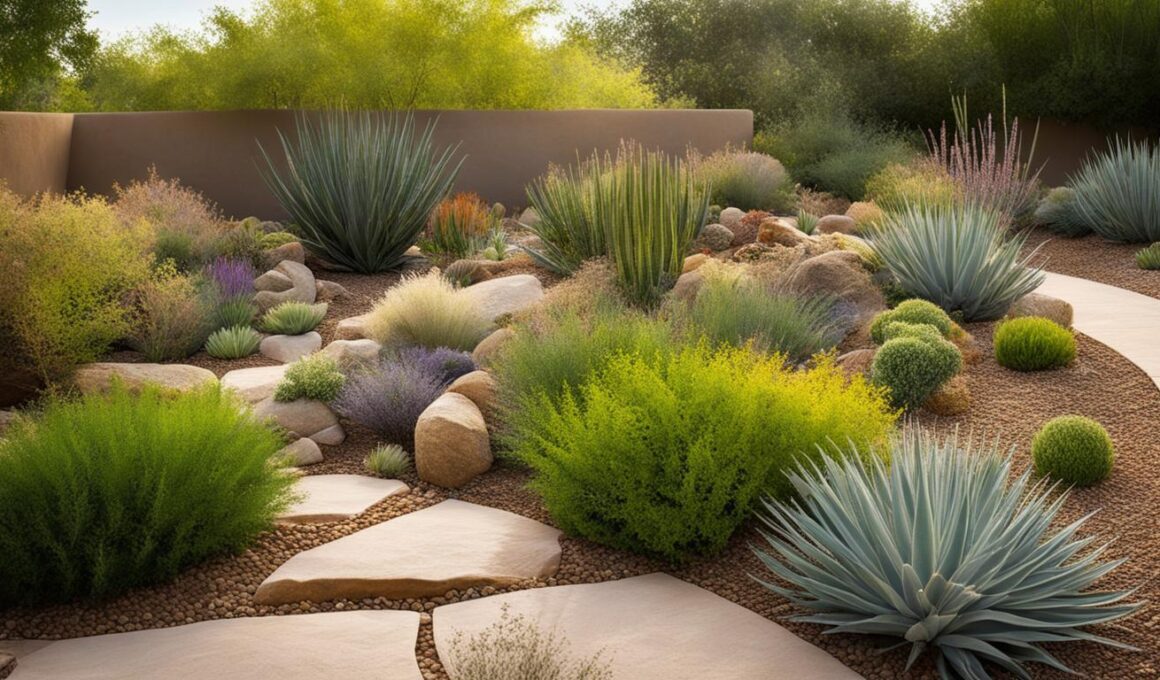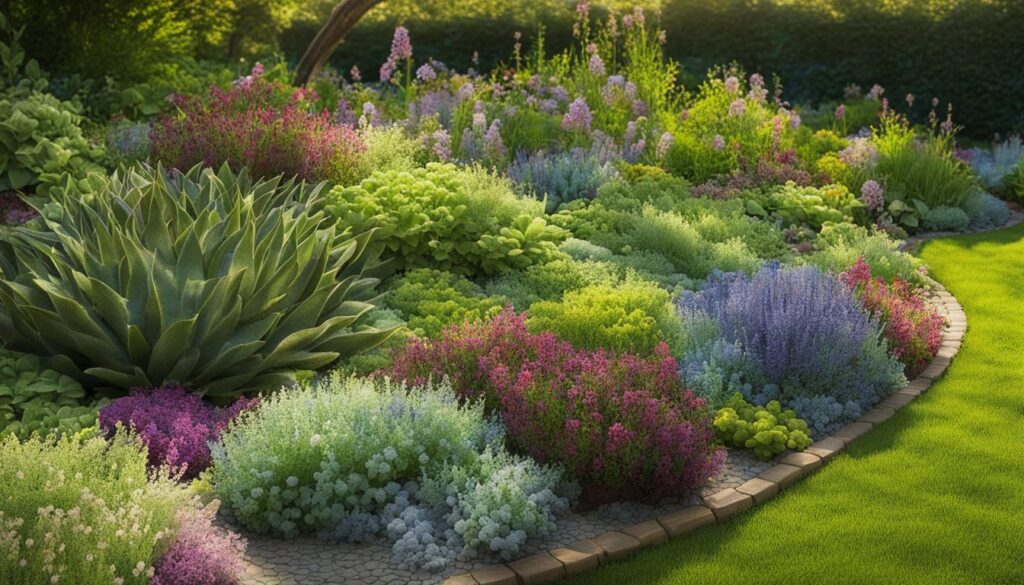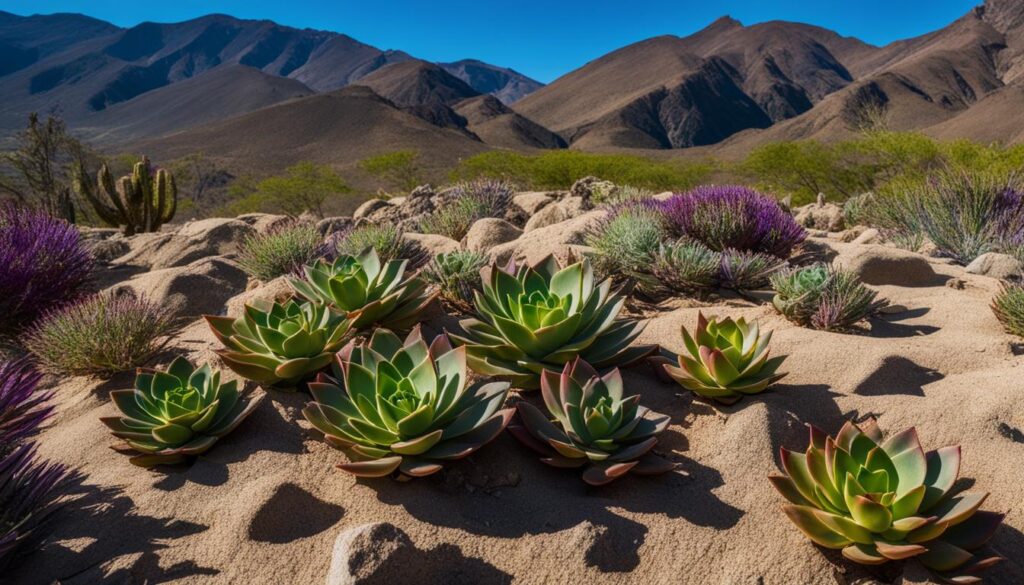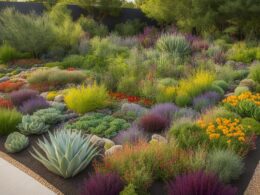Xeriscaping, or climate appropriate planting, is a landscaping technique that conserves water and protects the environment. Contrary to popular belief, xeriscaping does not mean only planting cacti and succulents. There are a wide variety of climate appropriate plants that can thrive in xeriscaped gardens, including drought-tolerant perennials, grasses, and shrubs. By choosing the right xeriscaping plants, you can create a lush and beautiful garden that requires less water and is more environmentally friendly.
Key Takeaways:
- Xeriscaping is a landscaping technique that conserves water and protects the environment.
- There are a variety of climate appropriate plants that can thrive in xeriscaped gardens.
- Choosing drought-tolerant perennials, grasses, and shrubs is essential for a successful xeriscape garden.
- Xeriscaping can create a lush and beautiful garden that requires less water and is more environmentally friendly.
- By implementing xeriscaping principles, such as proper planning and targeted irrigation, you can create a sustainable garden.
The Benefits of Xeriscaping
Xeriscaping offers numerous benefits that make it an attractive option for homeowners. One of the main advantages is water conservation. By using climate appropriate plants that require less water, you can significantly reduce your outdoor water usage. This not only helps to conserve water, but it also leads to reduced water bills. In areas where water is scarce or expensive, xeriscaping can make a significant difference in your monthly expenses.
Another benefit of xeriscaping is sustainable gardening. Traditional gardening methods often rely on artificial irrigation and the use of chemicals, which can have a negative impact on the environment. Xeriscaping, on the other hand, promotes sustainable practices by reducing the need for excessive watering and the use of harmful chemicals. It is a more environmentally friendly approach that supports the health of your garden and the surrounding ecosystem.
Drought-tolerant plants for xeriscaping
- Penstemon spectabilis – a blue-flowering perennial that attracts pollinators and copes well with heat extremes.
- Helleborus argutifolius – a Mediterranean plant with vibrant lime green flowers that can tolerate low watering.
- Pelargoniums (geraniums) – a variety of types and colors that add both color and scent to your xeriscape garden.
- Sempervivums (houseleeks) – succulent perennials that create intricate patterns as ground covers.
- Eschscholzia (California poppy) – a drought-tolerant wildflower that adds a splash of color to your garden.
- Lupins – native North American plants that thrive in dry and sunny locations, providing early summer flower color.
In addition to these benefits, xeriscaped gardens are low-maintenance and can thrive even during periods of drought. This means less time spent on watering, weeding, and other maintenance tasks, allowing you to enjoy your garden more and stress less about its upkeep.
Overall, xeriscaping is a practical and sustainable solution for creating a beautiful garden while conserving water and reducing your environmental impact. By choosing climate appropriate plants and implementing xeriscaping principles, you can create a lush and thriving garden that is both aesthetically pleasing and environmentally responsible.
Essential Principles of Xeriscaping
Proper planning, turfgrass reduction, targeted irrigation, mulching, and regular maintenance are key principles to follow when creating a successful xeriscape garden.
To start, effective planning is crucial for a thriving xeriscape garden. Consider the sunlight and shade patterns in your yard, and group plants with similar water needs together. This will ensure that each plant receives the appropriate amount of water and sunlight for optimal growth.
Another important principle is to minimize the use of turfgrass. Lawns require a significant amount of water to maintain, so consider replacing them with ground covers or other climate-appropriate plants. Not only will this reduce water consumption, but it will also add visual interest and variety to your garden.
Targeted irrigation is another essential aspect of xeriscaping. Drip irrigation systems, for example, deliver water directly to the root zone of plants, reducing water waste and promoting efficient water usage. By watering plants at their root level, you can avoid excess evaporation and ensure that water reaches the areas that need it most.
Mulching is a beneficial practice in xeriscaping as it helps retain moisture in the soil and reduce water evaporation. Apply a layer of organic mulch around your plants to conserve water and suppress weed growth. Mulch also acts as an insulator, protecting plant roots from extreme temperatures.
Finally, regular maintenance and pruning are essential for a thriving xeriscape garden. As plants grow larger, they may require additional water, so monitoring their growth and adjusting irrigation accordingly is important. Pruning helps control the size of plants and promotes healthy growth, reducing their water needs in the process.
Key Principles of Xeriscaping:
- Proper planning to determine sunlight and shade patterns
- Turfgrass reduction by replacing with ground covers or climate-appropriate plants
- Targeted irrigation systems, such as drip irrigation
- Mulching to retain moisture and reduce water evaporation
- Regular maintenance and pruning to prevent excessive water needs
By following these essential principles of xeriscaping, you can create a beautiful and sustainable garden that conserves water and thrives in a variety of climate conditions.
Ground Covers for Xeriscaping
Ground covers are an essential component of xeriscaping as they serve various purposes, such as providing visual interest, preventing soil erosion, and reducing water needs. They are low-growing plants that spread quickly and create a dense cover over the ground, suppressing weeds and conserving moisture. Here are some popular ground covers that are well-suited for xeriscaping:
- Sedum rubrotinctum: Also known as the jelly bean plant, Sedum rubrotinctum is a succulent ground cover with bean-shaped leaves and yellow star-shaped flowers. Its fleshy leaves store water, making it drought-tolerant and perfect for xeriscaped gardens.
- Pachysandra procumbens: Allegheny spurge, or Pachysandra procumbens, is a shade-loving ground cover that thrives in dry conditions. It features attractive foliage and has good drought tolerance.
- Ophiopogon japonicus: A tiny grass-like ground cover, Ophiopogon japonicus, or dwarf lilyturf, can tolerate both damp and slightly drier conditions. It forms dense clumps and is ideal for filling in gaps in your xeriscape garden.
- Ophiopogon planiscapus: Black mondo grass, or Ophiopogon planiscapus, is a low-growing ground cover with dark foliage that adds a striking contrast to your garden. It is exceptionally hardy and requires little water to thrive.
- Aloe aristata: Lace aloe, or Aloe aristata, is a compact succulent that forms rosettes of sawtoothed spikes. Its globular shape and vibrant green color make it an interesting choice for a ground cover in xeriscape gardens.
These ground covers offer both aesthetic appeal and practical benefits in xeriscaping. When selecting ground covers for your garden, consider factors such as water requirements, sunlight exposure, and soil conditions. By incorporating these climate appropriate plants into your xeriscape design, you can create a beautiful and sustainable landscape that conserves water and reduces maintenance needs.
Drought-Tolerant Perennials for Xeriscaping
Drought-tolerant perennials are an excellent choice for xeriscaping as they can withstand dry conditions and still provide color and beauty to your garden. These resilient plants require less water, making them perfect for regions with limited water resources.
One stunning option is Penstemon spectabilis, also known as the royal penstemon. With its vibrant blue flowers, it not only adds a pop of color to your xeriscape garden but also attracts pollinators like bees and hummingbirds. This perennial can tolerate heat extremes, ensuring its beauty even during scorching summers.
Another fantastic choice is Helleborus argutifolius, commonly known as Corsican hellebore. This Mediterranean plant boasts attractive lime green flowers that bloom in late winter, adding a cheerful touch to your garden during the colder months. It is highly drought-tolerant and requires minimal watering.
“Xeriscaping gardens can still be lush and vibrant with the right selection of drought-tolerant perennials that add color and beauty while conserving water.” – Professional Gardener
For those looking to add both color and scent to their xeriscape garden, Pelargoniums, also known as geraniums, are an excellent choice. These perennials come in a variety of types and colors, providing endless possibilities to suit your personal taste and garden theme. Additionally, their resilience in hot and dry conditions makes them a popular choice for xeriscaping.
If you’re interested in ground covers that not only conserve water but also create intricate patterns, consider Sempervivums, or houseleeks. These succulent perennials form tight rosettes and come in a range of colors, adding visual interest and texture to your xeriscape landscape. They are incredibly low-maintenance and thrive in dry conditions.
Another stunning option for xeriscaping is Eschscholzia, or California poppy. This drought-tolerant wildflower produces beautiful blooms in shades of orange, yellow, and gold, creating a vibrant display in your garden while requiring minimal water. It is an excellent choice for adding a splash of color to your xeriscape garden.
Lastly, Lupins are native North American plants that can thrive in dry and sunny locations. These perennials are loved for their tall spikes of vibrant flowers in hues of pink, purple, blue, and white. They are a great addition to any xeriscape garden, providing early summer flower color and attracting pollinators.
Xeriscaping Tips:
- Choose drought-tolerant perennials suited to your climate for a successful xeriscape garden.
- Group plants with similar water needs together for efficient irrigation.
- Consider using mulch around plants to retain moisture and suppress weed growth.
- Regularly monitor and adjust watering schedules based on weather conditions and plant needs.
- Perform regular maintenance, including pruning and removing dead or damaged foliage, to keep your xeriscape garden looking its best.
Drought-Tolerant Shrubs for Xeriscaping
Drought-tolerant shrubs are excellent additions to any xeriscape garden, providing both structure and beauty while requiring minimal watering. These shrubs are adapted to survive in arid conditions and can thrive in environments with limited water resources. Here are three drought-tolerant shrubs that are perfect for xeriscaping:
Lomandra
Lomandra is an Australian native shrub with grassy foliage that offers year-round interest in your xeriscape garden. It can adapt to both sun and shade, making it a versatile choice for different areas of your yard. Lomandra requires minimal watering once established and is highly tolerant of drought. Its attractive, fine-textured leaves add visual appeal to your landscape, creating a lush and natural look. Consider planting Lomandra as a border or as a focal point in your xeriscape garden.
Yucca
Yucca is a striking architectural plant that can withstand extreme conditions, including drought. Its starburst form and sword-like leaves make it a unique addition to your xeriscape garden. Yucca is highly adaptable and can thrive in well-drained soil and full sun. This low-maintenance shrub requires minimal watering once established, making it a perfect choice for water-wise landscapes. Placing Yucca in your xeriscape garden adds visual interest and creates a focal point that will stand out.
Manzanita
Manzanita is a small native North American tree that can be pruned and shaped as a shrub. It offers beautiful flowers and attractive bark, providing year-round interest in your xeriscape garden. Manzanita is highly valued for its ability to withstand drought and its contribution to pollinator habitat. This evergreen shrub requires minimal watering once established and is an excellent choice for adding both beauty and ecological value to your xeriscape garden. Consider incorporating Manzanita as an accent plant or in groupings for a dramatic effect.
By incorporating drought-tolerant shrubs like Lomandra, Yucca, and Manzanita into your xeriscape garden, you can create a sustainable and visually appealing outdoor space. These shrubs not only add structure and height to your landscape but also require minimal watering, reducing your water usage and contributing to water conservation efforts. With their ability to thrive in arid conditions, these shrubs are the perfect choice for xeriscaping projects.
Trees for Xeriscaping
Trees are an essential component of xeriscaping, providing shade, beauty, and habitat for wildlife in your garden. When selecting trees for your xeriscape, it’s crucial to choose drought-tolerant varieties that can withstand arid conditions while adding visual interest to your outdoor space. Two excellent choices for xeriscaping are Yucca rostrata and Manzanita.
Yucca rostrata is a tree-like yucca with a captivating starburst form and distinctive long, narrow leaves. It can thrive in well-drained soil, full sun, and even in drier, shaded areas. Yucca rostrata’s ability to tolerate drought and extreme conditions makes it an ideal choice for xeriscape gardens. Its architectural silhouette adds a touch of elegance to any landscape, and its unique form serves as a focal point or accent plant in your xeriscape design.
Manzanita trees are small, native North American trees that offer year-round interest with their attractive flowers and distinctive bark. These evergreen trees are highly valued for their winter appeal, adding texture and color to the xeriscape garden. Manzanita’s delicate blossoms attract pollinators and complement the surrounding landscape. With their fragrant foliage and fascinating bark, Manzanita trees bring a sense of tranquility and natural beauty to any xeriscaped outdoor space.
How Can I Choose Xeriscape Plants That Will Provide Seasonal Color Changes?
When choosing xeriscape plants for seasonal color changes, consider low-water options like yarrow, lavender, and Russian sage. These plants not only thrive in dry climates but also provide beautiful xeriscape seasonal color changes throughout the year, adding visual interest and pops of color to your landscape.
Conclusion
Xeriscaping offers numerous benefits for your outdoor space, ranging from water conservation to sustainable gardening practices. By incorporating climate appropriate plants and following the principles of xeriscaping, you can create a beautiful and environmentally friendly garden that thrives even in water-limited areas.
Using drought-tolerant ground covers, perennials, shrubs, and trees in your xeriscape garden not only adds visual interest but also promotes water conservation. These plants are adapted to thrive in dry conditions, reducing the need for excessive watering. By choosing the right plants for your climate, you can create a lush and colorful space while minimizing water usage.
Implementing the essential principles of xeriscaping, such as proper planning, reducing turfgrass, targeted irrigation, and regular maintenance, ensures the long-term success of your xeriscape garden. By grouping plants with similar water needs and using techniques like mulching to retain moisture, you can further optimize water conservation in your garden.
By embracing xeriscaping and the use of climate appropriate plants, you can not only enjoy a beautiful garden but also contribute to water conservation efforts. Create a sustainable and vibrant outdoor space with xeriscaping, and reap the benefits of a water-efficient and environmentally conscious garden.














